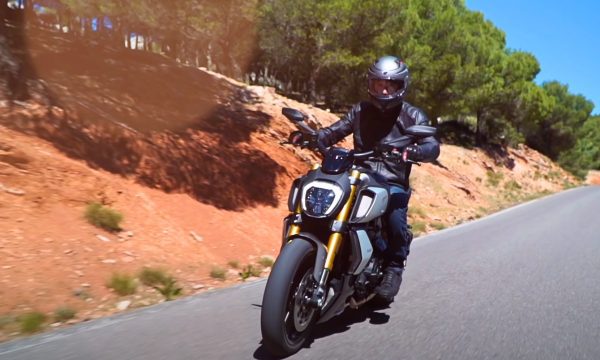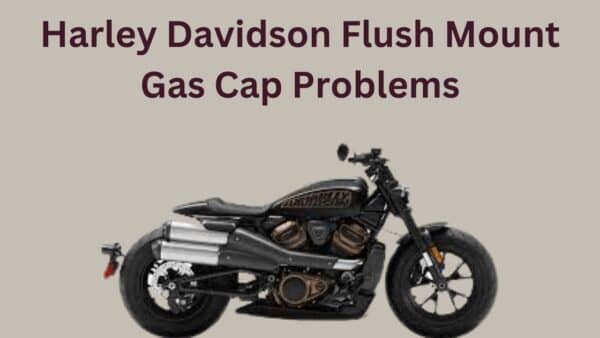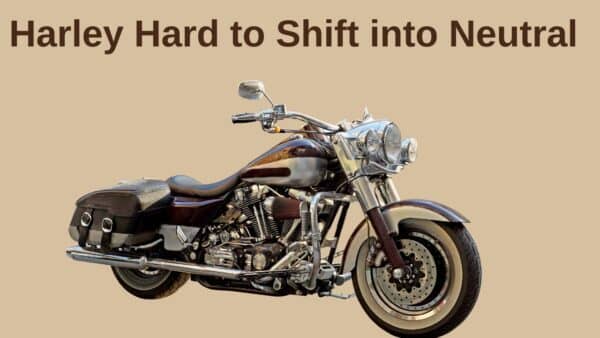The Ducati Diavel 1260 is known for its breathtaking power and sleek design, capturing the hearts of motorcycle enthusiasts worldwide.

However, like any mechanical marvel, it’s not without its issues.
In this article, we’ll discuss the most common problems faced by Diavel 1260 owners, and provide solutions.
Let’s begin!
Ducati Diavel 1260 Problems
Ducati Diavel 1260 problems are; surging at constant speeds, jerky second gear, oil drips and consumption, gear learning calibration issues, hot throttle and engine, fuel sensor issues, throttle slack, difficulty with low RPMs, unpredictable throttle response, issues with EU emissions restrictions.

1. Surging at Constant Speeds
This problem is characterized by the motorcycle feeling jumpy or unsteady instead of smoothly gliding along the road.
The reasons for this might be a glitch with the bike’s fuel mapping, or potential issues with its throttle response.
To address this, you should consider getting the motorcycle’s engine control unit (ECU) remapped by a professional, which recalibrates the fuel delivery.
On the other hand, regular maintenance and ensuring the throttle is correctly calibrated can also solve this issue.
2. Jerky Second Gear
Some riders have reported that when shifting up to second gear, the bike tends to jerk. This can be surprising and may even affect the bike’s handling temporarily.
This jerking motion could be due to, an imprecise gear change linkage, a clutch that isn’t engaging or disengaging smoothly, or software issues with the motorcycle’s ECU.
To resolve this, you should have the motorcycle checked by a professional. You might also need to adjust the gear linkage or the clutch components.
If the issues are related to the bike’s electronics, you can update your Ducati’s software to resolve the problem.
3. Oil Drips and Consumption
The Ducati Diavel 1260, can sometimes also face issues with oil drips and consumption.
You may notice oil spots on the ground where the bike is parked, or a need to top off the oil more frequently than usual.
This could be due to worn seals or gaskets, overfilling of oil, or even a more complex internal engine issue.
So, you should address the problem early and replace the seals or gaskets to resolve the minor leaks.
If issues persist you should consult with a certified mechanic for comprehensive diagnosis and professional repair.
4. Gear Learning Calibration Issue
This often results in a less smooth ride because the bike might jerk or hesitate when you try to change gears.
The reason for this can be traced back to the bike’s software, or due to a miscommunication between different parts of the bike’s transmission system.
To solve these gear calibration problems, you’ll need to update the motorcycle’s software.
Related: Ducati Multistrada 950 Problems
This can either be done at a dealership where professionals can ensure the bike gets the latest software patch, or by using a diagnostic tool.
Sometimes, a simple reset of the bike’s system by disconnecting and reconnecting the battery might also help.
5. Hot Throttle and Engine
This heating issue occurs due to the bike’s high-performance nature and its engine producing a lot of power and, consequently, a lot of heat.
Tight exhaust space and less airflow at lower speeds can also contribute to heat buildup.
To address this, you should ensure proper maintenance of the cooling system. Regularly check coolant levels and ensure the radiator is free from debris.
On the other hand, upgrading to high-quality engine oil designed for high-temperature operation can also solve the problem.
You should also take regular breaks during long rides to let the bike cool down, especially on hotter days.
6. Fuel Sensor Issues
A malfunctioning sensor may give wrong readings, which makes it hard to know how much fuel is actually left in the tank.
This can be frustrating for riders who rely on accurate fuel levels to plan their rides. There are a few reasons why fuel sensor issues might happen.
It could be because of a faulty sensor, dirt or corrosion on the sensor, or problems with the electrical connections that link the sensor to the bike’s computer.
To fix these issues, first, try cleaning the sensor to see if it’s just a matter of dirt buildup.
If that doesn’t work, you should also check the electrical connections. If they seem okay, it might be necessary to replace the fuel sensor with a new one.
7. Throttle Slack
This can make your bike feel less responsive and even jerky when trying to accelerate smoothly.
The root of this problem often lies in the throttle cable’s adjustment. Over time, cables can stretch slightly, resulting in slack.
Also, incorrect settings from the factory or after maintenance can contribute to this issue.
To resolve throttle slack, you should consider adjusting the throttle cable. This can often be done at home with some basic tools and reading the owner’s manual.
However, if you are less mechanically inclined or desire a professional touch, we advise visiting a certified Ducati mechanic.
They can ensure that the cable tension is set correctly for optimal performance and safety.
8. Difficulty with Low RPMs
This problem can make city riding less comfortable and affect the machine’s response during initial acceleration.
One possible reason for this issue is the engine’s tuning settings, which might not be optimal for low-speed maneuvers.
Another reason could be related to the fuel injection system, which can sometimes deliver fuel inconsistently at low RPMs.
Also, malfunctioning sensors can cause irregular engine behavior at low speeds.
To resolve these problems you can have the motorcycle’s ECU remapped or adjusted by a professional to improve low-RPM performance.
You can also regularly maintain a fuel system to ensure proper fuel flow. If sensors are to blame, you should test and replace them if found to be faulty.
9. Unpredictable Throttle Response
This unresponsive throttle problem can be disconcerting and potentially dangerous for both rider and motorcycle.
The cause might be attributed to software glitches within the bike’s electronic control unit (ECU), or possibly due to a faulty throttle position sensor.
To resolve this, you should initially try updating the motorcycle’s firmware at an authorized dealership, as this could rectify software-related concerns.
10. Issues with EU Emissions Restrictions
These rules aim to reduce pollution but can limit the bike’s engine capabilities.
Ducati has had to tweak the engine settings, which can sometimes result in lower power outputs or less aggressive throttle responses.
To comply without sacrificing performance, Ducati employs advanced technology like fine-tuned engine control units (ECUs) and exhaust systems to reduce emissions.
You can also opt for aftermarket solutions or rely on Ducati’s updates for a balance between eco-friendliness and Diavel’s signature ride experience.
Is Ducati Diavel 1260 Reliable
The Ducati Diavel 1260 is known for its reliability. This motorcycle has a strong engine and sturdy build quality.
Ducati has made sure the Diavel 1260 is made with care, which makes it a trustworthy ride for both short trips and long adventures.
Ducati Diavel 1260 User Review
The Ducati Diavel 1260 provides a one-of-a-kind riding experience that’s hard to come by elsewhere.
Despite its muscular look, the Diavel 1260 S surprises with its nimbleness, smoothly maneuvering corners like a smaller sports roadster.

It offers exciting acceleration, all-day riding comfort, advanced technology akin to top-tier sports bikes, and a striking style that commands attention.
User reviews highlight its powerful cruiser appeal paired with Ducati’s iconic style, the innovative DVT engine, and its impressive handling despite its size.
The Diavel 1260 excels in performance and specifications, standing out in its category with the nickname “MegaMonster.”
Riders appreciate its superb ride quality and brakes, noting a significant improvement in handling from its predecessor.
The new chassis design enhances comfort over bumps, with a seat designed for longer journeys without strain.
The Testastretta DVT 1262 engine is tuned for peak performance, delivering a sporty and aggressive ride with a captivating roar.
Equipped with Ducati’s latest rider aids, the Diavel 1260 offers a safe yet thrilling riding experience.
Owners praise its reliability, durability, and modern features like a two-way quick-shifter, Evo system for wheelie and launch control, and compatibility with the Ducati Link app.
Ducati Diavel 1260 Technical Specifications
| Specification | Detail |
| Mileage (Overall) | 18.5 kmpl |
| Displacement | 1262 cc |
| Engine Type | Ducati Testastretta DVT 1262, L-Twin cylinder, 4 valves per cylinder, Dual Spark, Desmodromic Variable Timing |
| No. of Cylinders | 2 |
| Max Power | 164.2 PS @ 9500 rpm |
| Max Torque | 129 Nm @ 7500 rpm |
| Front Brake | Disc |
| Rear Brake | Disc |
| Fuel Capacity | 17 L |
| Body Type | Sports Naked Bikes |
| ABS | Dual Channel |
| DRLs | Yes |
| Riding Modes | Yes |
| Traction Control | Yes |
| Cruise Control | Yes |
| Power Modes | Yes |
| Quick Shifter | Yes |
| LED Tail Light | Yes |
| Speedometer | Digital |
| Odometer | Digital |

Ahtsham Younas is a passionate blogger and content writer. He loves to ride motorcycles and learn the mechanical process behind the motorcycles.
He has been writing articles in the motorcycle industry since 2019 and has learned many things about motorbike niches.


